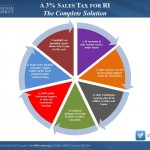Fiscal Analysis: Math of a 3.0% sales tax is budget friendly
No Budget Cliff:
A legitimate concern for lawmakers when considering sales tax reform, is avoiding severe revenue shortfalls and managing the state’s monthly cash flow. In considering dropping the RI Sales Tax to 3.0%, creating up to 13,000 jobs and over $100 million in new annual revenues for cities and towns, due to growth in the retail shopping sector and related economic activities, it is important to describe how state revenues – in all categories – would be impacted.
Fiscal Projections:
In fiscal year 2015, it is estimated that the state of Rhode Island will take in sales tax revenue of about $938 million.
A static calculation assumes that no increased economic activity will occur as a result of the decreased sales tax rate, and that a reduction in the sales tax from 7% to 3% would result i a loss of 4/7 of the originally projected revenue, or a loss $536 million.
A dynamic calculation attempts to project the effect of increased activity that is expected to occur (in the first full fiscal year after implementation) and projects a net budget loss of only $47 million, as follows:
-$433 million in sales tax receipts: -$536 million straight-line calculation plus $83 million from new transactions. It is an economic truth that that increased retail activity would result from the lower consumer costs, producing increased transactions and, therefore, sales tax receipts higher than the static calculation, decreasing the net revenue loss in this category.
+$226 million in income tax receipts: With more economic activity, more taxable income will be paid to RI workers, from a) more people hired, b) more hours for existing workers, and c) higher salaries and pass-through-profits for existing employees or business owners.
+$42 million in cigarette tax receipts: With more people shopping in RI, more cigarettes will be purchased in the state.
+$3 million in alcohol tax receipts: With more people shopping in RI, more alcohol will be purchased in the state.
+$27 million in corporate tax receipts: Increased consumer activity will attract new corporations to the state and would likely lead to higher profits from existing corporations.
+104 million in other taxes and sources of revenue: With greater overall economic activity and population growth, and more money to spend by consumers, it can be expected that the state would realize increased receipts from gasoline, vehicle fees, estate, racing and athletic, bank deposits, tangible assets, realty transfer, health care providers fees, and public utilities taxes, as well as increases in court, university tuition, lottery, and other departmental receipts.
NET STATE BUDGET IMPACT: -$47 million
MUNICIPAL IMPACT: +119 million collectively; every city and town is expected to see increased revenue gains, due almost entirely to higher commercial property tax revenues, as a result of new and expanded business formation.
Budget Planning Process:
A number of tools exist for lawmakers to mitigate the budget impact of major sales tax reform. Even if the projected $48 million deficit is overly optimistic, prioritization of spending leaves ample room.
1) NON-ESSENTIAL SPENDING of over $225 million in non-critical programs were identified in the Center’s Spotlight On $pending report. Lawmakers can choose to prioritize spending so as to create the best opportunity to create jobs and can look at low-hanging fruit in the budget, such as:
- $23.4 million to return HealthSourceRI to the federal government
- $12 million 38 Studios annual bond payment
- $13 million in projected savings from reduced social services demand
2) ANNUAL BUDGET RECONCILIATION PROCESS, which routinely adjusts the budget in response to changes in revenue that often far exceed the projected sales tax revenue changes.
3) THIRD-QUARTER IMPLEMENTATION of sales tax reform, beginning the lower rate in the middle of the fiscal year on January 1, 2015 would essentially spread the budget impact over two budget cycles, requiring less savings in 2015 and enabling more flexibility for the 2016 budget.
Monthly Cash Flow:
From the figures above, the dynamic increases in receipts in many categories would occur almost immediately, as more shoppers flow into the state, buying a wide array of products, and more workers are hired. This means that annual, even monthly, gross receipts to the state are not likely to be severely interrupted at any significant level.
To see the complete 3% sales tax solution, go to our Sales Tax home page at RIFreedom.org/SalesTax .


Leave a Reply
Want to join the discussion?Feel free to contribute!